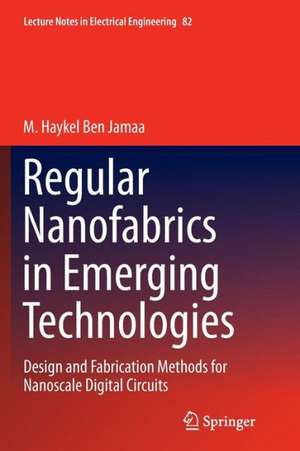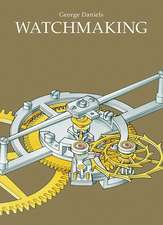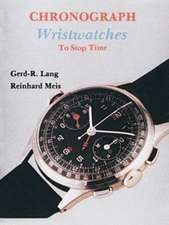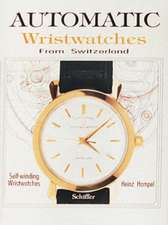Regular Nanofabrics in Emerging Technologies: Design and Fabrication Methods for Nanoscale Digital Circuits: Lecture Notes in Electrical Engineering, cartea 82
Autor M. Haykel Ben Jamaaen Limba Engleză Paperback – 21 apr 2013
| Toate formatele și edițiile | Preț | Express |
|---|---|---|
| Paperback (1) | 940.57 lei 6-8 săpt. | |
| SPRINGER NETHERLANDS – 21 apr 2013 | 940.57 lei 6-8 săpt. | |
| Hardback (1) | 941.05 lei 6-8 săpt. | |
| SPRINGER NETHERLANDS – 28 mar 2011 | 941.05 lei 6-8 săpt. |
Din seria Lecture Notes in Electrical Engineering
- 18%
 Preț: 1859.04 lei
Preț: 1859.04 lei - 18%
 Preț: 895.27 lei
Preț: 895.27 lei - 17%
 Preț: 397.66 lei
Preț: 397.66 lei - 18%
 Preț: 1562.17 lei
Preț: 1562.17 lei - 20%
 Preț: 1473.39 lei
Preț: 1473.39 lei - 18%
 Preț: 5169.60 lei
Preț: 5169.60 lei - 20%
 Preț: 1741.49 lei
Preț: 1741.49 lei - 20%
 Preț: 1918.04 lei
Preț: 1918.04 lei - 18%
 Preț: 1573.20 lei
Preț: 1573.20 lei - 18%
 Preț: 1851.77 lei
Preț: 1851.77 lei - 18%
 Preț: 1578.72 lei
Preț: 1578.72 lei - 18%
 Preț: 1903.08 lei
Preț: 1903.08 lei - 18%
 Preț: 2113.02 lei
Preț: 2113.02 lei - 18%
 Preț: 892.42 lei
Preț: 892.42 lei - 18%
 Preț: 1404.30 lei
Preț: 1404.30 lei - 18%
 Preț: 1133.61 lei
Preț: 1133.61 lei - 18%
 Preț: 1847.84 lei
Preț: 1847.84 lei - 18%
 Preț: 1384.56 lei
Preț: 1384.56 lei - 20%
 Preț: 1300.14 lei
Preț: 1300.14 lei - 20%
 Preț: 1174.76 lei
Preț: 1174.76 lei - 20%
 Preț: 1310.03 lei
Preț: 1310.03 lei - 18%
 Preț: 2546.29 lei
Preț: 2546.29 lei - 20%
 Preț: 1310.03 lei
Preț: 1310.03 lei - 18%
 Preț: 1676.58 lei
Preț: 1676.58 lei - 20%
 Preț: 1182.20 lei
Preț: 1182.20 lei - 18%
 Preț: 1392.46 lei
Preț: 1392.46 lei - 18%
 Preț: 1119.38 lei
Preț: 1119.38 lei - 18%
 Preț: 1678.16 lei
Preț: 1678.16 lei - 18%
 Preț: 1596.85 lei
Preț: 1596.85 lei - 18%
 Preț: 1398.00 lei
Preț: 1398.00 lei - 20%
 Preț: 1445.35 lei
Preț: 1445.35 lei - 18%
 Preț: 1244.89 lei
Preț: 1244.89 lei - 20%
 Preț: 1173.10 lei
Preț: 1173.10 lei - 18%
 Preț: 810.81 lei
Preț: 810.81 lei - 20%
 Preț: 1173.93 lei
Preț: 1173.93 lei - 20%
 Preț: 1482.47 lei
Preț: 1482.47 lei - 20%
 Preț: 1915.57 lei
Preț: 1915.57 lei - 18%
 Preț: 1387.73 lei
Preț: 1387.73 lei - 18%
 Preț: 1425.62 lei
Preț: 1425.62 lei - 20%
 Preț: 1297.67 lei
Preț: 1297.67 lei - 18%
 Preț: 1407.46 lei
Preț: 1407.46 lei - 18%
 Preț: 1667.91 lei
Preț: 1667.91 lei - 18%
 Preț: 1400.35 lei
Preț: 1400.35 lei - 18%
 Preț: 1117.03 lei
Preț: 1117.03 lei - 18%
 Preț: 1573.20 lei
Preț: 1573.20 lei - 18%
 Preț: 1405.90 lei
Preț: 1405.90 lei - 18%
 Preț: 726.37 lei
Preț: 726.37 lei - 18%
 Preț: 1405.90 lei
Preț: 1405.90 lei - 18%
 Preț: 1238.56 lei
Preț: 1238.56 lei - 18%
 Preț: 725.61 lei
Preț: 725.61 lei
Preț: 940.57 lei
Preț vechi: 1147.03 lei
-18% Nou
Puncte Express: 1411
Preț estimativ în valută:
180.03€ • 195.62$ • 151.33£
180.03€ • 195.62$ • 151.33£
Carte tipărită la comandă
Livrare economică 21 aprilie-05 mai
Preluare comenzi: 021 569.72.76
Specificații
ISBN-13: 9789400735705
ISBN-10: 9400735707
Pagini: 212
Ilustrații: XX, 192 p.
Dimensiuni: 155 x 235 x 11 mm
Greutate: 0.3 kg
Ediția:2011
Editura: SPRINGER NETHERLANDS
Colecția Springer
Seria Lecture Notes in Electrical Engineering
Locul publicării:Dordrecht, Netherlands
ISBN-10: 9400735707
Pagini: 212
Ilustrații: XX, 192 p.
Dimensiuni: 155 x 235 x 11 mm
Greutate: 0.3 kg
Ediția:2011
Editura: SPRINGER NETHERLANDS
Colecția Springer
Seria Lecture Notes in Electrical Engineering
Locul publicării:Dordrecht, Netherlands
Public țintă
ResearchCuprins
Acknowledgments. Contents.- 1 Introduction.- 2 Fabrication of Nanowire Crossbars.- 3 Decoder Logic Design.- 4 Decoder Test.- 5 Logic Design with Ambipolar Devices.- 6 Conclusions and Future Work. List of Acronyms.- List of Symbols.
Notă biografică
Haykel Ben Jamaa is a research engineer at the "Commissariat à l'Energie Atomique et aux Energies Alternatives (CEA-Léti)". He obtained his PhD degree in Electrical Engineering in September 2009 from the "Ecole Polytechnique Fédérale de Lausanne" (EPFL), Switzerland. He received his co-joint MSc degree in Electrical Engineering from the "Technische Universität München", Germany, and the "Ecole Centrale Paris", France, in 2004.
He is currently working in the field of nanotechnology with an interdisciplinary approach linking post-CMOS technologies to specific architectures. His research interests include the fabrication techniques for emerging and post-CMOS technologies and non-conventional and fault-tolerant design methodologies and styles for nanometer scale circuits, with a particular emphasis on novel fabrication and design technologies of silicon nanowire crossbar arrays. His expertise consists in linking device fabrication and circuit design; it covers cleanroom processing, device modelling and test, and fault-tolerant circuit design.
Previously, he was a visiting researcher at Stanford University, California, USA, a research fellow with the Max-Planck Institute for Solid-State Research in Stuttgart, Germany, and a mixed-signal designer with Infineon Technologies, Munich, Germany. He has been involved in the review process of prestigious conferences and journals (IEEE/ACM Design Automation and Test in Europe Conference - DATE, IEEE Transactions on Computer-Aided Design - TCAD, ACM Journal on Emerging Technologies in Computing Systems - JETC) and he was a TPC member of DATE in 2008, Nano-Net in 2009, NOCS in 2010 and VLSI-SoC in 2010. He obtained the ACM Outstanding Dissertation Award in EDA (2009).
Haykel Ben Jamaa also has a MA degree in Finances and Strategy from the "Institut d'Etudes Politiques de Paris", France. He was the president of EPFL'sresearchers and lecturers association in 2007-2009. He was an elected member of EPFL's School Assembly in 2007-2008. He was also an active member of other communities, such as the PhD Board of EPFL and the humanitarian mission MHIGE.
He is currently working in the field of nanotechnology with an interdisciplinary approach linking post-CMOS technologies to specific architectures. His research interests include the fabrication techniques for emerging and post-CMOS technologies and non-conventional and fault-tolerant design methodologies and styles for nanometer scale circuits, with a particular emphasis on novel fabrication and design technologies of silicon nanowire crossbar arrays. His expertise consists in linking device fabrication and circuit design; it covers cleanroom processing, device modelling and test, and fault-tolerant circuit design.
Previously, he was a visiting researcher at Stanford University, California, USA, a research fellow with the Max-Planck Institute for Solid-State Research in Stuttgart, Germany, and a mixed-signal designer with Infineon Technologies, Munich, Germany. He has been involved in the review process of prestigious conferences and journals (IEEE/ACM Design Automation and Test in Europe Conference - DATE, IEEE Transactions on Computer-Aided Design - TCAD, ACM Journal on Emerging Technologies in Computing Systems - JETC) and he was a TPC member of DATE in 2008, Nano-Net in 2009, NOCS in 2010 and VLSI-SoC in 2010. He obtained the ACM Outstanding Dissertation Award in EDA (2009).
Haykel Ben Jamaa also has a MA degree in Finances and Strategy from the "Institut d'Etudes Politiques de Paris", France. He was the president of EPFL'sresearchers and lecturers association in 2007-2009. He was an elected member of EPFL's School Assembly in 2007-2008. He was also an active member of other communities, such as the PhD Board of EPFL and the humanitarian mission MHIGE.
Textul de pe ultima copertă
Regular Nanofabrics in Emerging Technologies gives a deep insight into both fabrication and design aspects of emerging semiconductor technologies, that represent potential candidates for the post-CMOS era. Its approach is unique, across different fields, and it offers a synergetic view for a public of different communities ranging from technologists, to circuit designers, and computer scientists. The book presents two technologies as potential candidates for future semiconductor devices and systems and it shows how fabrication issues can be addressed at the design level and vice versa. The reader either for academic or research purposes will find novel material that is explained carefully for both experts and non-initiated readers. Regular Nanofabrics in Emerging Technologies is a survey of post-CMOS technologies. It explains processing, circuit and system level design for people with various backgrounds.
Caracteristici
Interdisciplinary approach to go through versatile topics (technology, design, architecture) that are necessary for the assessment of emerging nanotechnologies in electronics Numerous illustrations (images) to understand the technology part by a computer-scientist and many examples to explain the theoretical and computational problems to technologists Deep literature survey of the addressed problems Includes supplementary material: sn.pub/extras













